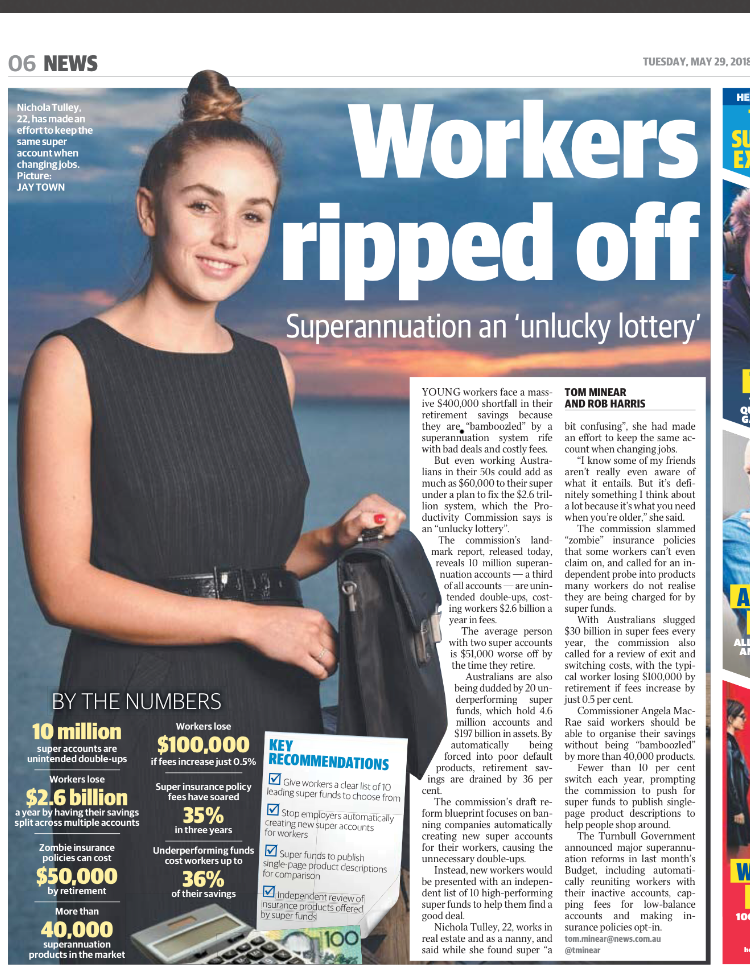Readers of my book, Blueprint to Wealth: Financial Freedom in 15 Minutes a Week, and followers of my blog writings over the years will be well aware of this latest revelation from the Productivity Commission in the article below.

Whilst my view is that it is years late, maybe decades, it is better late than never. And maybe just in time for the Royal Commission to pull the industry and retail Super Funds apart like a clock. But I’ll only believe that when it happens.
This information has been out there for all and sundry to see for years. Indeed, I wrote an article on just this over a year ago and couldn’t find a journalist to go anywhere near it. Maybe it just wasn’t newsworthy enough! Here are some of the points that I have made in the past, backed up with new data.
Firstly, according to the latest APRA Tables of June 2017 – tables 12 and 13 to be precise – 27.7% of Super accounts registered with APRA (all industry and retail Super funds & excl. SMSF’s), have balances of less than $1,000 and an average account balance of $223. That’s $1.636B across 7.344 million accounts – Table 13.
When minimum admin fees of between $55 and $85 p.a. are deducted from these accounts they will on average, be depleted in around 4 years. Add to this opt-out insurance deductions, mostly not needed and not known about, or “zombie insurances” as the article calls them, of around $100 p.a., on average, and these accounts are run to zero in less than 2 years.
This means that around $1.0B a year, and it’s been happening for years, has been pilfered from unsuspecting Super account holders, most of whom would be under 35 years of age. This, as the article says, is ripping off workers.
Thankfully the current federal government is trying to introduce a maximum annual fee rate of 3% for accounts under $6,000, but this needs to be passed as part of the 2018/19 federal Budget.
What are the fees?
Some industry Super Funds, who claim to have low fees, are charging over 2% p.a. for their Balanced funds, in which around 75% or workers invest their retirement savings! Whilst they have no doubt been doing this for years, they have only by law been required since 2017 to declare certain fees that they were charging but not declaring to their customers.
When long-term average returns are in the region of 8% p.a., funds are taking, on average, 25% or a quarter, of the average growth, every year, of peoples’ retirement savings, in fees for themselves.
Ok, so some industry Super Balanced funds have fees of around 1.1% p.a. Whew, not getting ripped off I hear you say! That depends on what you use as the benchmark. If you use the VAS ASX300 index ETF fees as a benchmark, at 0.14% p.a., then at 1.1% p.a. you are paying 7.8x per year more that you need to. At 2% p.a. you are paying 14.2x per year more!!
What about returns?
And then we come to returns and the many Super funds that are underperforming. The article, quoting the Productivity Commission, claims 20 Super Funds with $197B of assets under management are underperforming. Again, it depends on the benchmark being used. The odds are that they used the median returns of all Super funds. Poor benchmark!
Surely you should benchmark against an easily accessible alternative fund, for example the ASX300 index ETF. If that ETF was used over a period of 20 years, which is reasonable because the average time to retirement for all Super accounts is around 33 years, you would battle to find a single, that’s right, just ONE, Super fund that isn’t underperforming. The ASX300 index is accessible via the low-cost ETF, VAS as are many other indices, on the ASX and US markets.
What can you do about it?
Workers need to take their heads out of the sand, stop being apathetic and lazy about their Super and get some basic education on these matters. After all, starting to build a well only when you get thirsty will be too late.
When I look at the average Super account balances in APRA regulated Super funds, all 26 million of them, I know that nearly every APRA regulated account (excl. SMSFs) will battle to provide an independent and comfortable retirement. Why? Because a couple retiring today at age 65 needs around $1.0 million dollars to enjoy an independent and comfortable retirement. The APRA table below shows that most are a long way from that figure.

Source: APRA Annual Fund-level Superannuation Statistics, June 2017 edition.
Well done to the Productivity Commission for publicising this issue.
You can avoid a mid-retirement crisis and get some excellent education on these precise issues by signing up to the Blueprint to Wealth Investors Club. These are the topics covered in detail in a simple to use online training course that is part of the Club:
You can find more information about this online course here.
Here are some of the remarks left by current course attendees:
“I must congratulate you on this presentation so far, you have already made me realise some of the mistakes that I’m making. Thank you for being so generous with your knowledge. Great advice”
– Raymond.“This Blueprint to Wealth Investors Club training educational course is fantastic you have nailed it I have read the book but this is so easy to learn from congratulations I think you have created one of the best courses ever well done, I love the book but this is so much good info in easy to follow format and condensed into one powerful course.”
Thanks Gary, Guys, Team well done.
– Robert“Excellent positioning summary.
Should be a mandatory education module for all employed people from mid 30’s.
The understanding of disposable income saving (particularly through salary sacrifice superannuation vehicles) the effect of compounding in wealth creation etc, needs far more understanding/emphasis in today’s ‘spend-it-now-self-indulgent-instant-gratification’ society.”
– Leanne



